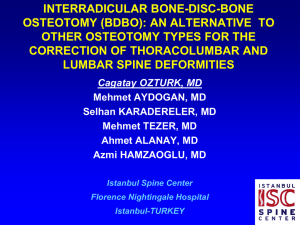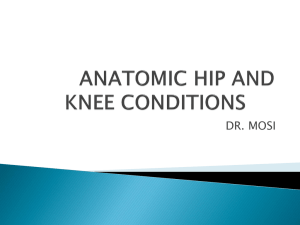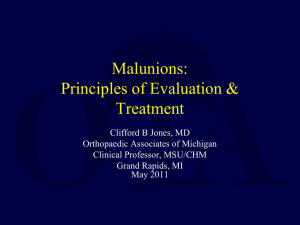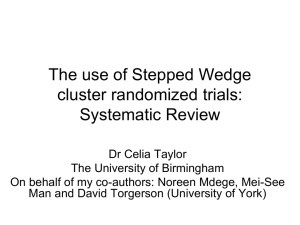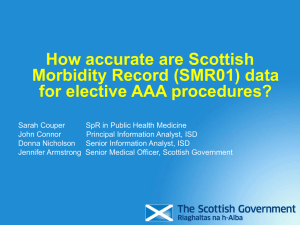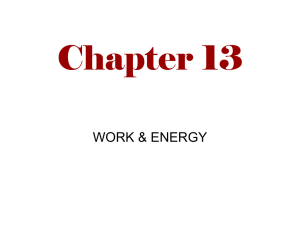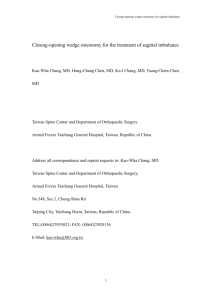Risk of aorta injury in patients treated by accomplishing an anterior
advertisement
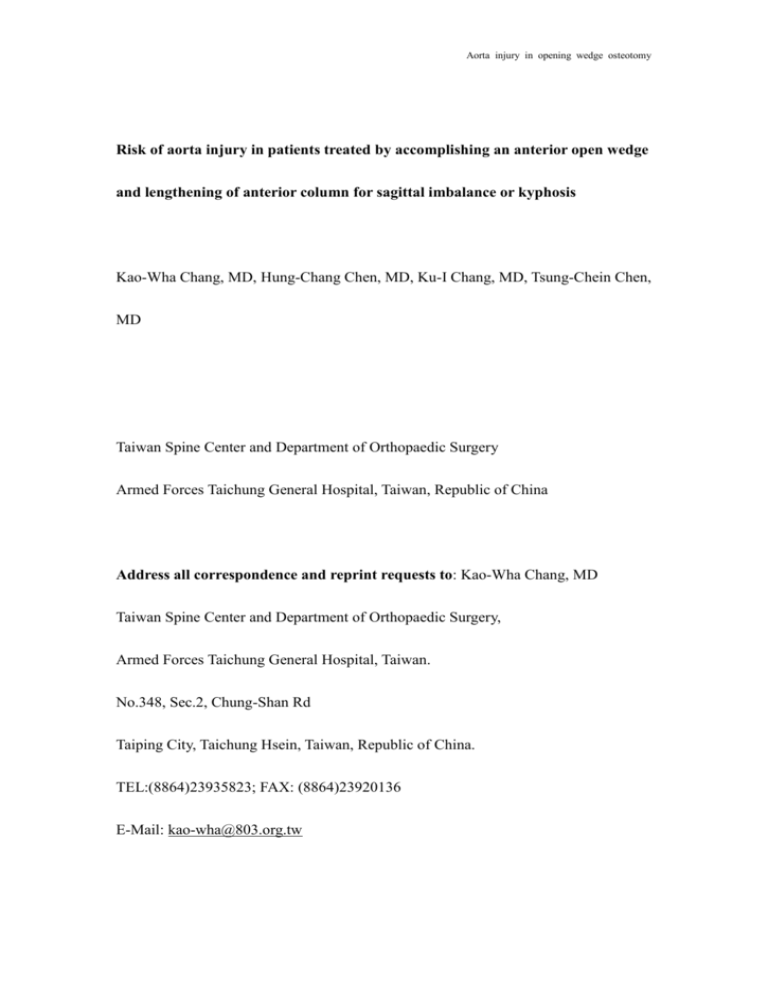
Aorta injury in opening wedge osteotomy Risk of aorta injury in patients treated by accomplishing an anterior open wedge and lengthening of anterior column for sagittal imbalance or kyphosis Kao-Wha Chang, MD, Hung-Chang Chen, MD, Ku-I Chang, MD, Tsung-Chein Chen, MD Taiwan Spine Center and Department of Orthopaedic Surgery Armed Forces Taichung General Hospital, Taiwan, Republic of China Address all correspondence and reprint requests to: Kao-Wha Chang, MD Taiwan Spine Center and Department of Orthopaedic Surgery, Armed Forces Taichung General Hospital, Taiwan. No.348, Sec.2, Chung-Shan Rd Taiping City, Taichung Hsein, Taiwan, Republic of China. TEL:(8864)23935823; FAX: (8864)23920136 E-Mail: kao-wha@803.org.tw Aorta injury in opening wedge osteotomy ABSTRACT Study Design: Retrospective Objectives: To inspect the suspected dominant roles of aorta injury including aorta elongation at the level of osteotomy in patients with athromatous calcification and propose a probable mechanism of aorta injury associated with treatment for sagittal imbalance. Summary of Background Data: Fatal aortic rupture has previously been reported in four patients, all associated with opening wedge osteotomy. Methods: Consecutive patients (n=354) with kyphotic deformity or sagittal imbalance achieved an anterior open wedge and lengthening of anterior column by opening wedge osteotomy (Group A, n=141), apical lordosating osteotomy (Group B, n=79), and closing-opening wedge osteotomy (Group C, n=134) without aortic injury. Radiographic analysis of the four suspected dominant roles was performed. Results: No aorta-anterior longitudinal ligament adhesion was found any patient. The mean lengthening of aorta with athromatous calcification at the level of osteotomy was 2.8 cm (range 1.7–3.5). Sagittal translation of vertebral column occurred with frequencies of 31% (Group A), 7% (Group B), and 21% (Group C). Spike formation at the edges of an anterior open wedge occurred only in Group A (7%). Conclusion: Aortic tolerance of lengthening at a single level is exceptional, even with Aorta injury in opening wedge osteotomy athromatous calcification. For a calcific aorta, spike formation at the edges of an anterior open wedge combined with or without sagittal translation of vertebral column probably was the major mechanism of aorta injury during the corrective procedures for sagittal imbalance or kyphosis. Key words: aorta injury, apical lordosating osteotomy, closing-opening wedge osteotomy, opening wedge osteotomy Aorta injury in opening wedge osteotomy Key Points Aortic tolerance of lengthening at a single level was exceptional, even with athromatous calcification. Spike formation at the edges of the anterior open wedge combined with or without sagittal translation of cephalad or caudad vertebral column probably was the major mechanism of aorta injury in ankylosing spondylitis patients with calcific aorta treated with opening wedge osteotomy. No aorta injury occurred in patients treated with apical lordosating osteotomy or closing-opening wedge osteotomy, likely because of the absence of spike formation at the edges of the anterior open wedge. Aorta injury in opening wedge osteotomy Mini Abstract Consecutive patients (n=354) with kyphotic deformity or sagittal imbalance achieved an anterior open wedge and lengthening of anterior column without aortic injury. Aortic tolerance of lengthening at a single level was exceptional, even with athromatous calcification. Spike formation at the edges of the anterior open wedge combined with or without sagittal translation of vertebral column probably was the major mechanism of aorta injury. Aorta injury in opening wedge osteotomy INTRODUCTION In elderly patients, anterior column lengthening at a single level carries the potentially catastrophic risk of elongation of the tethered aorta or calcific nondistensible aorta1-3. We have conducted opening wedge osteotomy4 (OWO), closing-opening wedge osteotomy5 (COWO) and apical lordosating osteotomy6 (ALO) (Fig 1A-C) for correction of sagittal imbalance in 354 patients. The absence of aortic injury associated with anterior open wedge and lengthening of anterior column at a single level was an encouraging prelude to the present study. Herein we report on our investigation of suspected dominant roles of aorta injury including aorta elongation at the level of osteotomy in patients with advanced athermatous degeneration and marked calcification seen roentgenographically in the aorta, sagittal translation of vertebral column, spike formation at the edges of the anterior open wedge, and adhesion between aorta and anterior longitudinal ligament. Furthermore, we propose a probable mechanism of aorta injury associated with anterior column lengthening at a single level by OWO. MATERIALS AND METHODS Patients We retrospectively reviewed the medical records of 354 consecutive patients who underwent OWO for kyphotic deformity (n=141, group A), apical lordosating Aorta injury in opening wedge osteotomy osteotomy in cord territory for thoracic or thoracolumbar kyphotic deformity (n=79, group B), cauda equina COWO for sagittal imbalance or kyphotic deformity (n=134, group C). All patients were managed by one surgeon at Armed Forces Taichung General Hospital from 1990–2005. Group A was comprised of 129 men and 12 women (mean age 32.1 years, range 16–49) diagnosed with ankylosing spondylitis with kyphotic deformity. Group B was comprised of 18 men and 61 women (mean age 70.3 years, range 58–78) diagnosed with thoracic or thoracolumbar osteoporotic kyphosis as a result of single or multiple vertebral compression fracture. Group C was comprised of 51 men and 83 women (mean age 68.1 years, range 52–78) diagnosed with flatback syndrome with instrumented lumbar fusion (n=16), degenerative kyphosis (n=28), degenerative kyphoscoliosis (n=43), posttraumatic kyphosis (n=15), iatrogenic kyphosis (n=13), and ankylosing spondylitis (n=19). All these surgical procedures involved an anterior open wedge and lengthening of the anterior column at a single level. No aorta injury occurred in any patient. Of the 354 patients in groups A–C, 101 displayed athermatous deposits and calcification in the abdominal aorta that were discerned by plain radiographs. Among these patients, 49 displayed athromatous calcification marks exactly opposite the level of osteotomy seen roentgenographically in the aorta. The 49 patients (35 females and 14 males, mean age 67.5 years, age range 59.1–76.3) comprised group D. Group D treatment for correction of sagittal Aorta injury in opening wedge osteotomy imbalance or kyphotic deformity included ALO at L1 (n=4) and COWO at L2 or L3 (n=45). Preoperative diagnosis in the group D patients was flatback syndrome with instrumented lumbar fusion (n=7), ankylosing spondylitis (n=7), degenerative kyphosis (n=9), degenerative kyphoscoliosis (n=11), traumatic kyphosis (n=8), and iatrogenic kyphosis (n=7). Radiographic analysis Four suspected dominant roles of aorta injury were inspected roentgenographically at the level of osteotomy. Anterior column and aortic lengthening Anterior column lengthening at the level of osteotomy was measured by comparing the pre- and postoperative length difference between the distance between the cephalad and caudad endplates of the osteomized vertebrae. The aorta lengthening at the level of osteotomy was measured by comparing the pre- and postoperative length difference between the distance between the arthromatous calcification marks exactly opposite the osteotomized vertebrae (Fig. 2). Only group D patients could undergo this radiographic analysis according to pre-and postoperative radiographs, because the aorta lengthening could not be measured in patients without calcified marks exactly opposite the osteotomized vertebra. Sagittal translation of vertebral column Aorta injury in opening wedge osteotomy Sagittal translation in group A patients was any measurable displacement more than 2 mm between the posterior inferior edge of the cephalad vertebral body and the posterior superior edge of the caudad vertebral body at the OWO level (Figs. 3A and 3B). Sagittal translation in group B, C, and D patients was any measurable displacement more than 2 mm between the posterior inferior edge of the cephalad portion of the osteotomized vertebral body and the posterior superior edge of the caudad portion of the osteotomized vertebral body (Fig. 3C). Spike formation at the edges of the anterior opening wedge The edges of the anterior opening wedge of all patients were inspected with magnifying glass to search for spikes (Fig. 4). Adhesion between aorta and anterior longitudinal ligament A gap between the posterior wall of aorta and anterior longitudinal ligament at the level of osteotomy identified preoperatively by plain radiographs, computed tomography, or magnetic resonance imaging was indicative of a lack of adhesion between the two structures (Fig. 5). RESULTS The mean anterior column lengthening at the level of osteotomy of the 49 group D patients was 2.4 cm. The aorta lengthening averaged 2.8 cm (range 1.7–3.5). Aorta and anterior column lengthening at the level of osteotomy were comparable (Fig. 2). Aorta injury in opening wedge osteotomy Sagittal translation occurred in 44 of the 141 group A patients (31%), seven of the 79 group B patients (9%), 28 of the 134 group C patients (21%), and eight of the 49 group D patients (16%) (Fig 3). All the edges of the anterior open wedges were smooth and without spike formation in patients of groups B, C, and D. Ten of the 141 patients of group A (7%) developed spikes at the edges of the anterior open wedge after OWO (Fig 4). In all patients with or without athermatous calcification seen roentgenographically in the aorta, the posterior wall of the aorta and anterior longitudinal ligament at the level of osteotomy displayed roentgenographic evidence of separation (Fig. 5A), with the exception of 18 group D patients who presented with a large anteriorly protruding degenerative osteophyte. In the latter, a gap could not be identified preoperative between the two structures (Fig. 5B). In eight of these 18 patients, migration of the athermatous calcification mark in the aorta wall located caudad to the osteophyte preoperatively to a location cephalad to the osteophyte postoperatively, or visa-versa, was evident upon comparison of the calcification mark on the pre-and post-operative radiographs (Fig. 5C), which was evidence of a lack of adhesion between the aorta and the osteophyte. DISCUSSION Fatal aortic rupture associated with the creation of an anterior open wedge and Aorta injury in opening wedge osteotomy anterior lengthening of the lumbar spine has been reported in four patients1–3. Of particular concern, two patient had preoperative x-ray therapy that produced adherence between the aorta and the underlying anterior longitudinal ligament and resulted in a complete transverse tear in the posterior wall of the aorta after manual osteoclasis and non-surgical or surgical correction1,2. Presently, none of the retrospectively studied patients had preoperative x-ray therapy. Moreover, we found nothing in the pathologies of the etiologies that raised concern of an aorta-anterior longitudinal ligament adhesion. With the exception of the patients with large anteriorly protruding, degenerative osteophytes at the osteotomized vertebra, preoperative imaging revealed a gap between the two structures at the level of osteotomy. Observations of postoperative migration in some group D patients indicates that degenerative osteophytes do not produce adherence between the two structures. Nonetheless, patients who have had preoperative X-ray therapy or an operation between aorta and anterior longitudinal ligament that can produce adherence between the two structures may be at risk of aortic injury following an anterior open wedge and lengthening of anterior column for correction kyphosis, if not accompanied by the freeing of the attached, relatively fixed aorta by a two-stage procedure. The other two vascular injuries evident in the literature3 include a tear in the wall Aorta injury in opening wedge osteotomy of aorta and dissection of media. These were related to one-level OWO for the three ankylosing spondylitis patients with athromatous calcification of their abdominal aorta. Stretching of calcific and nondistensible aorta may have created internal and media tears, leading to rupture and aneurysm. However, presently we observed no occurrence of aortic injury in 101 patients with athromatous calcification of their abdominal aorta in whom sagittal correction was accomplished by an anterior open wedge and lengthening of anterior column. Our findings concerning measurements of aortic lengthening support the view that the aorta tolerates stretching and lengthening exceptionally well, even with athermatous calcification. Our findings run counter to the conventionally-held view. In the operations described for the aforementioned two patients3, the spine was osteotomized through the posterior element and corrected by direct pressure on the osteotomy site (L2-3). The upper body and legs were extended to form a hollow cavity between the patient’s ventral trunk and the surgical table, and the pressure caused the ossified anterior vertebral column to fracture. If occurring with a sudden snap, avulsion of a bone fragment from the vertebral body can form a spike (Fig 4), which can injure the aorta while the anterior wedge is opened. Before 1993, 39 of the 141 group A patients underwent manual osteoclasis and OWO with a similar maneuver. Ten of the 39 patients developed spikes at the edges of the open wedges. Aorta injury in opening wedge osteotomy Fortunately, our patient criteria for OWO were an age of less than 50 years and the absence of athromatous calcification of aorta4. So, despite spike formation, no vascular injury occurred in these 10 patients, likely owing to a sufficiently flexible aorta. After 1993, if osteoclasis occurred at the intervertebral disc at the level of osteotomy during performed posterior osteotomy by gravity of the patient’s trunk or by light pressure on the osteotomy site after osteotomy, we consistently observed that the edges of the anterior open wedge were smooth and without spike formation. If the ossified anterior vertebral column was too hard to be fractured by light pressure, a fluoroscopically guided osteotome was placed through the intervertebral disc at the level of the osteotomy. Then, osteoclasis was formed by gentle manipulation. In this way, that osteoclasis that forms occurs at the anterior disc space. Correction should not be started without assured osteoclasis and is accomplished by a slow and finely controlled closure of the osteotomy. As the posterior wedge is closed, correction occurs in the anterior vertebral column by opening of the anterior disc space with smooth edges. Unlike OWO, in which the whole anterior an middle vertebral columns can be fractured by manual osteoclasis, potentially resulting in spike formation, the thin anterior cortex of the osteotomized vertebral body fractures in a greenstick manner, and opens with smooth edges and without spike formation during the corrective Aorta injury in opening wedge osteotomy procedures of COWO and ALO. Accordingly, no spike was found in patients of groups B, C, and D. Previously, we have demonstrated that sagittal translation is one of the basic mechanisms for correction of sagittal imbalance in ankylosing spondylitis by OWO (Figs. 3A and 3B)7. Similar to OWO, the ALO, and COWO procedures involve three-column release and unrestricted movement of the hinge of correction, which can produce sagittal translation (Fig. 3C). Sagittal translation subjects the aorta to an anteriorly directed force in addition to stretch. In the presence of sagittal translation, spike formation at the anterior edges of the open wedge might result in a stabbing injury of the tensed aorta or internal media tears due to stress concentration effect. While the absence of X-ray and postmortem information makes confirmation impossible, we believe spike formation combined with or without sagittal translation very probably was the main mechanism responsible for the aorta injury in the three cases. Aorta injury in opening wedge osteotomy References 1. Lichtblau PO, Wilson PD. Possible mechanism of aorta rupture in orthopaedic correction of rheumatoid spondylitis. J Bone Joint Surg Am 1956;38:123-7. 2. Klems VH, Friedebold G. Ruptur der Aorta abdominalis nach Aufrichtungsoperation bei Spondylitis ankylopoetica. Z Orthop 1971;108:554-63. 3. Weatherly C, Jaffary D, Terry A. Vascular complications associated with osteotomy in ankylosing spondylitis: a report of two cases. Spine 1988;13:43-6. 4. Chang KW, Chen YY, Lin CC, et al. Closing wedge osteotomy versus opening wedge osteotomy in ankylosing spondylitis with thoracolumbar kyphotic deformity. Spine 2005;30:1584-93. 5. Chang KW, Chen HC, Chang KI, et al. Closing-opening wedge osteotomy for the treatment of sagittal imbalance. Spine 2007, submitted. 6. Chang KW, Chen YY, Lin CC, et al. Apical lordosating osteotomy and minimal segment fixation for the treatment of thoracic or thoracolumbar osteoporotic kyphosis. Spine 2005;30:1674-81. 7. Chang KW, Chen HC, Chen YY, et al. Sagittal translation in opening wedge osteotomy for the correction of thoracolumbar kyphotic deformity in ankylosing spondylitis. Spine 2006;31:1137-42. Aorta injury in opening wedge osteotomy FIGURE LEGENDS Figure 1. Diagrams of opening wedge osteotomy (A and B), apical lordosating osteotomy (C and D), and closing-opening wedge osteotomy (E and F). A. Lateral view outlining the bone block to be resected. Total pediculectomy avoided nerve root compression by the remaining pedicle. B. Postoperative lateral view depicting the correction achieved by vertebral body posterior border hinging, of vertebral body, closure of the posterior osteotomy, and creation of an anterior column open wedge. C. Lateral view depicting the bone block to be resected. D. Postoperative lateral view depicting the correction achieved by lordotic cage hinging and creation of an opening wedge of the anterior column. The lordotic cages were used to maintain the height of middle column, preventing cord kinking after correction. E. Lateral view depicting the bone block to be resected. F. Postoperative view depicting the correction achieved by hinging on the closed middle column, closing the intravertebral osteotomy, and creating an open wedge of the anterior column. Figure 2. Data from a 67-year-old Group D patient with iatrogenic kyphosis treated with closing-opening wedge osteotomy at L2. A. Presurgical image showing 75o kyphosis, 15 cm sagittal balance, 61o T12–S1 lordosis, and athromatous calcification marks exactly opposite L2. Final values were -30o (kyphosis), 3 cm Aorta injury in opening wedge osteotomy (sagittal balance), and -55o (T12–S1 lordosis). B. Anterior column lengthening (2.2 cm) determined by measuring the difference in length between black arrows pre- and postoperatively. Aorta lengthening was 2.4 cm by measuring the difference in length between white arrows pre- and postoperatively. The black arrows indicate the same points of the cephalad and caudad endplate of the osteotomized vertebra before and after operation. The white arrows indicate the same athromatous calcified marks exactly opposite to osteotomized vertebra before and after operation. Aorta and anterior column lengthening were comparable. Figure 3. Sagittal translation data. A. Cephalad vertebral column sagittal translation in OWO. B. Caudad vertebral column sagittal translation in OWO. C. Sagittal translation in COWO. Figure 4. Spike formation in OWO for ankylosing spondylitis kyphosis. Figure 5. Imaging of posterior wall of aorta. A. A gap between the posterior wall of aorta and anterior longitudinal ligament could be identified by plain radiographs. B. A gap between posterior wall of aorta and the large anteriorly protruding degenerative osteophyte could not be identified by plain radiographs and magnetic resonance Aorta injury in opening wedge osteotomy imaging. C. The athromatous calcification mark in the aorta (black arrow) located caudad to the osteophyte preoperatively migrated to a location cephalad to the osteophyte postoperatively demonstrated no adhesion between the two structures. Aorta injury in opening wedge osteotomy Aorta injury in opening wedge osteotomy Aorta injury in opening wedge osteotomy Aorta injury in opening wedge osteotomy Aorta injury in opening wedge osteotomy Aorta injury in opening wedge osteotomy Aorta injury in opening wedge osteotomy Aorta injury in opening wedge osteotomy Aorta injury in opening wedge osteotomy
